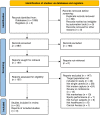Healthcare applications of single camera markerless motion capture: a scoping review
- PMID: 35642200
- PMCID: PMC9148557
- DOI: 10.7717/peerj.13517
Healthcare applications of single camera markerless motion capture: a scoping review
Abstract
Background: Single camera markerless motion capture has the potential to facilitate at home movement assessment due to the ease of setup, portability, and affordable cost of the technology. However, it is not clear what the current healthcare applications of single camera markerless motion capture are and what information is being collected that may be used to inform clinical decision making. This review aims to map the available literature to highlight potential use cases and identify the limitations of the technology for clinicians and researchers interested in the collection of movement data.
Survey methodology: Studies were collected up to 14 January 2022 using Pubmed, CINAHL and SPORTDiscus using a systematic search. Data recorded included the description of the markerless system, clinical outcome measures, and biomechanical data mapped to the International Classification of Functioning, Disability and Health Framework (ICF). Studies were grouped by patient population.
Results: A total of 50 studies were included for data collection. Use cases for single camera markerless motion capture technology were identified for Neurological Injury in Children and Adults; Hereditary/Genetic Neuromuscular Disorders; Frailty; and Orthopaedic or Musculoskeletal groups. Single camera markerless systems were found to perform well in studies involving single plane measurements, such as in the analysis of infant general movements or spatiotemporal parameters of gait, when evaluated against 3D marker-based systems and a variety of clinical outcome measures. However, they were less capable than marker-based systems in studies requiring the tracking of detailed 3D kinematics or fine movements such as finger tracking.
Conclusions: Single camera markerless motion capture offers great potential for extending the scope of movement analysis outside of laboratory settings in a practical way, but currently suffers from a lack of accuracy where detailed 3D kinematics are required for clinical decision making. Future work should therefore focus on improving tracking accuracy of movements that are out of plane relative to the camera orientation or affected by occlusion, such as supination and pronation of the forearm.
Keywords: Clinical motion capture; Markerless; Markerless motion capture; Musculoskeletal; Neurological injuries; Scoping review; Single camera human motion analysis; Single camera markerless motion capture; Single camera movement analysis of humans; Telerehabilitation.
©2022 Scott et al.
Conflict of interest statement
The authors declare there are no competing interests.
References
-
- Adde L, Helbostad JL, Jensenius AR, Taraldsen G, Grunewaldt KH, Støen R. Early prediction of cerebral palsy by computer-based video analysis of general movements: a feasibility study: early computer-based Prediction of CP. Developmental Medicine & Child Neurology. 2010;52:773–778. doi: 10.1111/j.1469-8749.2010.03629.x. - DOI - PubMed
-
- Alwan M, Rajendran PJ, Kell S, Mack D, Dalal S, Wolfe M, Felder R. A Smart and passive floor-vibration based fall detector for elderly. 2006 2nd international conference on information communication technologies; 2006. pp. 1003–1007. - DOI
-
- Bazarevsky V, Grishchenko I, Raveendran K, Zhu T, Zhang F, Grundmann M. BlazePose: on-device real-time body pose tracking. 20202006.10204 [cs]
Publication types
MeSH terms
LinkOut - more resources
Full Text Sources


